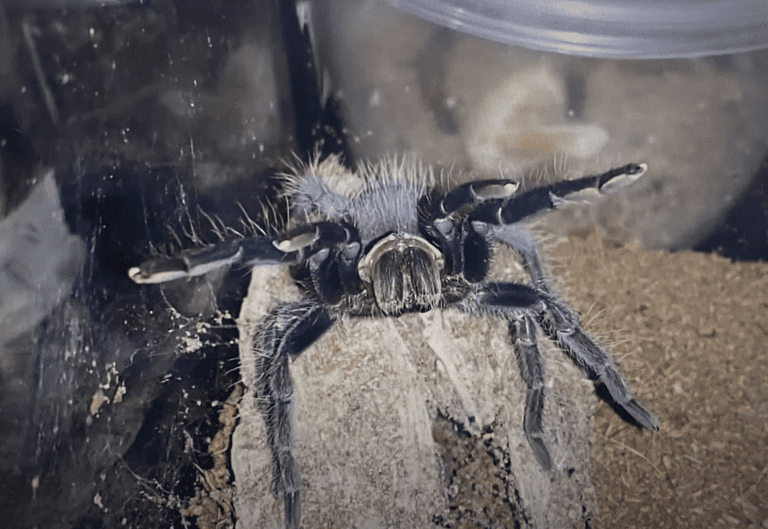Tarantula Behavior Explained: A Guide for New Pet Owners
A tarantula’s behavior can be quite mysterious, especially as they spend much of their time hidden away in the wild. Understanding tarantula behavior is key to becoming familiar with the changes they undergo, such as shifts before molting and seasonal behavior adjustments. While much of their behavior is still not fully understood, recognizing these patterns can help arachnid keepers better care for their pets.”
However, pet tarantulas can also experience behavior shifts when the seasons change. Fall and winter can cause tarantulas to lose their appetite and even become less active despite their enclosure conditions remaining the same. This can cause concern for tarantula owners, but it is completely normal. After all, there is a reason why some people believe tarantulas to be “pet rocks.”
With this in mind, understanding tarantula behavior can make these arachnids more entertaining to observe and keep as pets.
Burrowing
Although some tarantulas are arboreal, many dig burrows as slings and during the molting process as a way of protecting themselves. When they are vulnerable and small, they are easier prey for birds, insects, and wasps, so hiding is the best scenario. If this is the case, as these tarantulas grow larger, they will begin to feel more comfortable outside of their burrows.
This behavior can worry new tarantula owners, especially when it looks like the tarantula is trapped under the substrate. The best advice is to leave the tarantula alone during this time; it is simply following its instincts and natural behavior. It will have lined the walls of its burrow with its web, which keeps the substrate from shifting, and will emerge when it feels safe to do so.
Burrowing is more common with ground-dwelling tarantulas.
What Does a Tarantula Burrow Look Like?
A typical tarantula burrow has silk threads around the entrance, which is the main feature that differentiates it from other animals’ hides, like a mouse hole. The entrance will look like a clearly defined hole with a diameter of an inch or more.
Fight or Flight: Key Aspects of Tarantula Behavior
As the burrowing behavior shows, most tarantulas prefer to hide than face a potential threat. Tarantulas, like other arachnids, have a strong fight-or-flight instinct. When it feels threatened and hiding is not an option, a tarantula will hold most of its weight on its hind legs, expose its fangs, and sometimes raise its first pair of legs to make itself appear bigger. This aspect of tarantula body language is primarily an intimidation tactic used to scare attackers away.
If that tactic fails, a tarantula will then use its urticating hairs as a defense mechanism. It uses its legs to shoot these bristles toward the predator. These hairs cause minor irritation to humans, but they can prove fatal to small mammals.

Tarantula Behavior During Hunting: How They Capture Prey
With weak eyesight, tarantulas typically depend on sensations and their sense of touch to hunt. This is why they have so many sensitive setae. These bristle-like hairs allow the tarantula to feel shifts in the air and vibrations on the ground, which helps to pinpoint the location of prey.
Tarantulas stalk in the direction the vibrations are coming from before seemingly grabbing their prey out of nowhere. They bite their prey, injecting venom that immobilizes it before their saliva begins digesting solid parts of their meal.
To find out about what pet tarantulas can eat, click here.
Tarantula Behavior During Mating: The Courtship Ritual
Once a male tarantula reaches sexual maturity, which is shown by the development of tibial spurs and bulbous pedipalp tips, its main objective is to mate with as many females as it can before death. At this stage of its life, it will begin to prepare “sperm webs,” which are used to deposit sperm on and “charge” its pedipalp tips (also known as palpal bulbs).
During mating season, which varies from species to species, males come out of hiding and begin searching for females. This is when tarantulas are most visible. They will travel to find a receptive female; this is done by tapping the silk threads at a female’s burrow to alert her of his presence and waiting to see if she will leave the burrow to meet the male. Some females will refuse to leave their burrows or even chase the males away.
A courtship ritual will begin once the male tarantula finds a receptive female. The rituals displayed will vary depending on the species, although drumming the pedipalps and vibrating its body are the most common movements. This is how the male shows if he is a suitable mate. If the female accepts, she will either tap her pedipalps and legs or simply leave her burrow completely.
Copulation will begin once the male has carefully maneuvered the female into the correct position; the male is very vulnerable at this point. However, once both tarantulas are in the right position, the male will insert his pedipalps into the female’s epigyne.
If the male escapes the female’s burrow without being eaten, he will begin searching for his next mate.
Understanding tarantula behavior throughout their life stages, from hunting to mating and defense mechanisms, helps pet owners better connect with and care for their fascinating companions.
